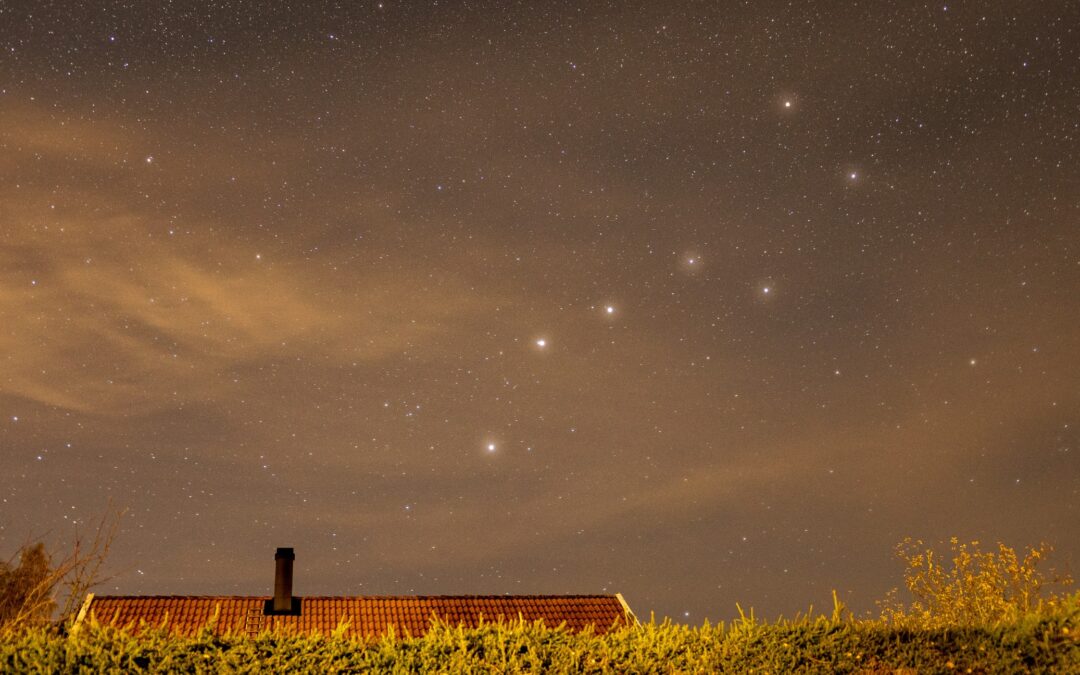
by William Parker | Feb 6, 2023 | Education, Observatory, Observatory Events, Repeating
Wednesday, February 8, 6:00 pm – 8:00 pm ; Wednesday, February 15 & 22, 6:30 pm – 8:30 pm
Relax in a zero-gravity chair with your own wine or beverage you bring while we guide you through the night sky, using our laser pointer to show you stars, planets, constellations, galaxies, and other objects of interest while explaining their relationships and significance.
These events are weather-dependent, and will be rescheduled by e-mail 24 hours before scheduled if the cloud cover forecast is greater than 40%.
Dress appropriately for nighttime outdoor weather.
Purchase tickets here or email observatory@hawthornhollow.org.

by William Parker | Feb 6, 2023 | Observatory, Observatory Events, Repeating
Monday, February 6, 6:00 pm – 8:00 pm ; Monday, February 13, 20, & 27; 6:30 pm – 8:30 pm
Relax in a zero-gravity chair while we guide you through the night sky, using our laser pointer to show you stars, planets, constellations, galaxies, and other objects of interest while explaining their relationships and significance.
These events are weather-dependent and will be rescheduled by e-mail 24-hours before the scheduled start time in the event of a cloud cover forecast greater than 40%.
Dress appropriately for being still in nighttime outdoor weather.
Purchase tickets here or email observatory@hawthornhollow.org

by William Parker | Jan 28, 2023 | Observatory, Observatory Events, One-Time
Saturday (Apr. 22) 9:00 pm – 11:00 pm
The Lyrids appear in Chinese writing dating back to roughly 690 BCE, making them one of the earliest meteor showers on record. On the night of April 22, the annual shower will reach its peak for 2023. The meteor shower is a result of Earth passing through the tail of the comet C/1861 G1 Thatcher. When our planet moves through this debris field, the space rocks burn up in Earth’s atmosphere, causing spectacular lights to streak across the night sky.
The Lyrids are one of the weaker annual meteor showers visible from Earth. On peak nights, they usually produce no more than 20 shooting stars per hour. The event is also unpredictable: On rare occasions, spectators are treated to incredible surges of up to 100 meteors per hour. For this reason, the Lyrids are worth checking out for diehard astronomy enthusiasts.
Come out to the Heide Observatory and enjoy a relaxing evening in our anti-gravity chairs as we point out the night-sky objects and watch for meteors.
Tickets and chairs are limited so reserve soon.
This event is weather-dependent and will be canceled or rescheduled by e-mail 24 hours before the scheduled start time in the event of a cloud cover forecast greater than 30%. Reservations can be transferred for any other nightly observatory event.
Dress appropriately for being still in nighttime outdoor weather.
Questions? Feel free to contact us at observatory@hawthornhollow.org
Purchase tickets here, or call 262-552-8196.

by Chad Jocius | Jan 25, 2023 | Observatory, Observatory Events, One-Time
Tonight January 31 6:30 – 8:30 pm
The comet C/2022 E3 (ZTF) could be bright enough to be spotted with the naked eye as it passes the sun and Earth at the end of the first month of 2023. At the start of 2023 Earth will be visited by a newly discovered comet that may just be bright enough to be spotted with the naked eye.
The comet, named C/2022 E3 (ZTF), is currently passing through the inner solar system. It will make its closest approach to the sun, or perihelion, on Jan. 12, and will then whip past Earth making its closest passage of our planet, its perigee, between Feb. 1 and Feb. 2.
If the comet continues to brighten as it currently is, it could be visible in dark skies with the naked eye. This is difficult to predict for comets, but even if C/2022 E3 (ZTF) does fade it should still be visible with binoculars or a telescope for a number of days around its close approach. According to NASA Jet Propulsion Laboratory (JPL), the comet has a period of around 50,000 years. This means that prior to it coming to within around 100 million miles (160 million kilometers) of the sun on Jan. 12 and 26 million miles (42 million kilometers) of Earth on Feb. 2, the last time it came so close was during the Upper Paleolithic period on Earth.
Clear skies for tonight Tuesday, January 31 at 6:30 pm Click here for tickets !

by Chad Jocius | Dec 13, 2022 | Education, Observatory, Observatory Events, Repeating
Wednesdays, 6:00 pm – 8:00 pm
Relax in a zero-gravity chair with your own wine or beverage you bring while we guide you through the night sky, using our laser pointer to show you stars, planets, constellations, galaxies, and other objects of interest while explaining their relationships and significance.
These events are weather-dependent, and will be rescheduled by e-mail 24 hours before scheduled if the cloud cover forecast is greater than 40%.
Dress appropriately for nighttime outdoor weather.
Purchase tickets here or email observatory@hawthornhollow.org.

by Chad Jocius | Dec 13, 2022 | Observatory, Observatory Events, Repeating
Thursdays, 6:00 pm – 8:00 pm
Take turns looking through our 16-inch telescope at binary stars, dim planets, distant galaxies, and other sky objects. Between individual views in the observatory dome, receive a guided sky tour standing outside under the stars to appreciate the broader picture of what you see through the telescope.
These events are weather-dependent, and will be rescheduled by e-mail 24 hours before scheduled if the cloud cover forecast is greater than 40%.
Dress appropriately for nighttime outdoor weather.
Purchase tickets here or email observatory@hawthornhollow.org.





